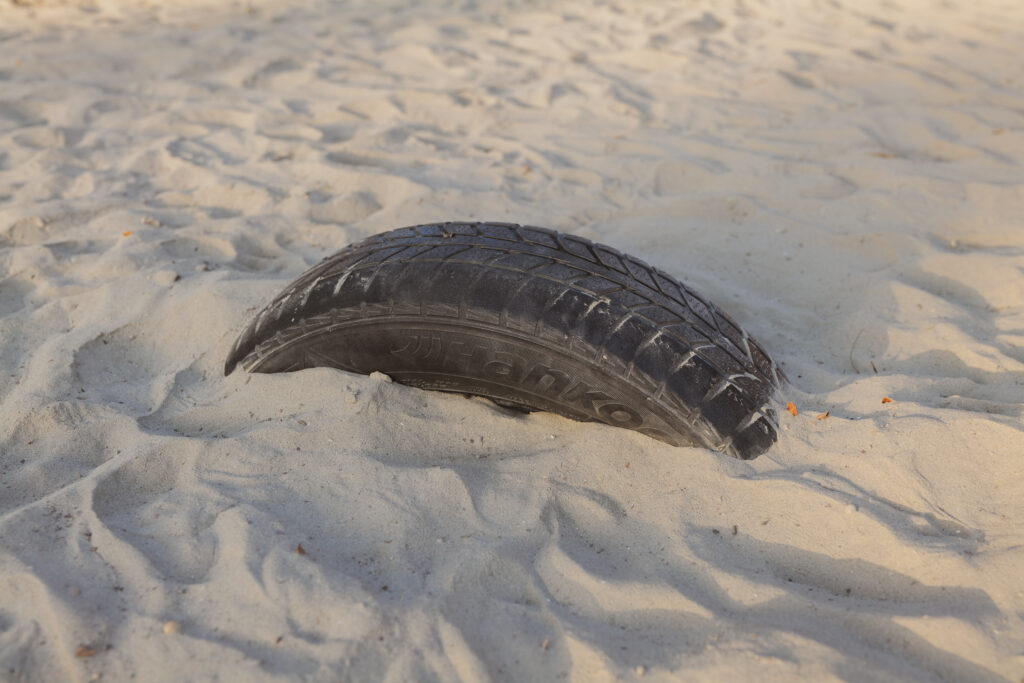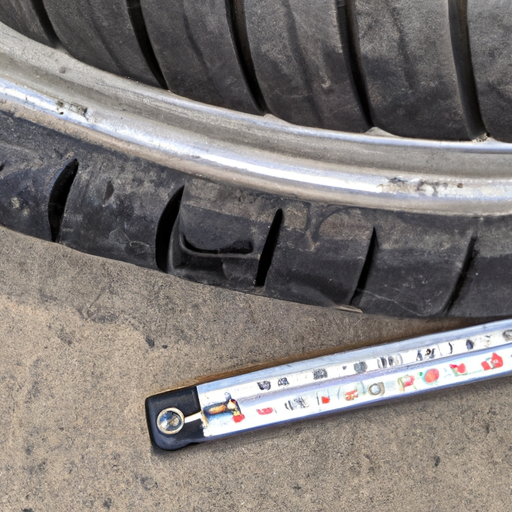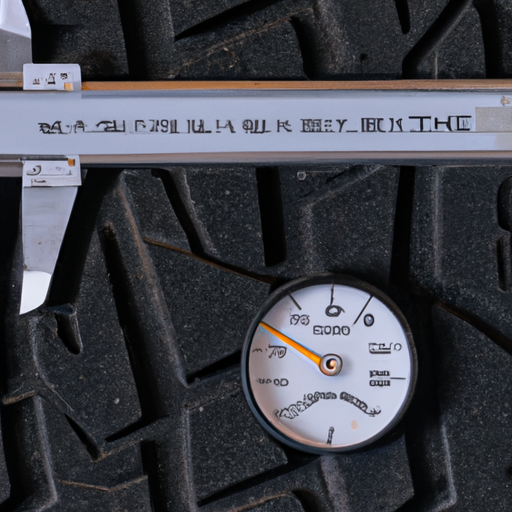You love taking road trips, feeling the wind against your face as you explore new places. But as a responsible driver, you understand the importance of maintaining your car, especially its tires. Tire tread depth is a crucial factor in ensuring proper traction and safety on the road. So, how can you measure tire tread depth accurately? In this article, we will guide you through simple and effective methods that will help you determine if it’s time to replace your tires, giving you peace of mind on your next adventure.
Methods for measuring tire tread depth
When it comes to measuring tire tread depth, there are several methods you can choose from. Each method has its own advantages and can provide you with an accurate measurement. Let’s take a closer look at some of these methods:
Visual inspection
The first method for measuring tire tread depth is a simple visual inspection. This method involves visually examining the tire to determine the depth of the tread. By looking at the tire, you can get a rough estimate of how much tread is remaining.
Using a tread depth gauge
A tread depth gauge is a specialized tool designed specifically for measuring tire tread depth. It is a simple and effective way to obtain a precise measurement. With a tread depth gauge, you can measure the depth of the tread with great accuracy.
Using a coin
Another method for measuring tire tread depth is using a coin. This method is quick and easy, making it a popular choice for many car owners. By inserting a coin into the tire groove, you can determine whether the tread depth is sufficient or if it’s time for a replacement.
Measuring wear indicators
Tire manufacturers often include wear indicators in their tire designs. These indicators allow you to easily measure the tire tread depth. By locating the wear indicator bars and measuring the depth using a ruler, you can determine if your tire tread is within the acceptable range.
Importance of measuring tire tread depth
Measuring tire tread depth is crucial for various reasons. Let’s take a closer look at why it is important to regularly measure the tread depth of your tires:
Safety
One of the primary reasons for measuring tire tread depth is safety. Adequate tread depth plays a vital role in maintaining proper traction on the road. It helps your tires maintain contact with the surface, reducing the risk of accidents, especially in wet or slippery conditions.
Traction control
Measuring tire tread depth is essential for maintaining optimal traction control. The grooves in the tire tread designed to channel away water, snow, and mud, allowing your tires to grip the road effectively. When your tires have worn-out treads, their ability to grip the road is compromised, negatively impacting your vehicle’s traction control.
Fuel efficiency
Proper tire tread depth also contributes to fuel efficiency. When your tires have adequate tread depth, they provide better rolling resistance and improved mileage. On the other hand, if your tires have worn-out treads, they can cause increased rolling resistance, leading to decreased fuel efficiency and higher fuel consumption.
Legal requirements
In many jurisdictions, there are legal requirements for minimum tire tread depth. These laws are in place to ensure road safety for all drivers. By regularly measuring your tire tread depth, you can ensure that your tires meet the legal requirements, avoiding potential fines or penalties.

Visual inspection
Visual inspection is the simplest method for measuring tire tread depth. By visually examining your tires, you can gather valuable information about their overall condition. Here are some key points to consider when conducting a visual inspection:
Understanding tire tread wear patterns
Tire tread wear patterns can provide important insights into the condition of your tires. By knowing how to identify different wear patterns, you can gauge the effectiveness of your tires and detect any potential issues. Common tread wear patterns include even wear, shoulder wear, center wear, and cupping wear.
Identifying signs of uneven wear
During a visual inspection, it is important to identify any signs of uneven wear. Uneven wear can indicate alignment issues, suspension problems, or improper tire inflation. By catching these issues early on, you can address them promptly and prevent further damage to your tires.
Inspecting for tread depth indicators
Tire manufacturers often incorporate tread depth indicators into their tire designs. These indicators appear as small bars molded into the groove of the tire tread. By inspecting these indicators during a visual inspection, you can determine if the tire has reached the recommended tread depth for replacement.
Using a tread depth gauge
Using a tread depth gauge is a reliable and accurate method for measuring tire tread depth. Follow these steps to effectively measure your tire tread using a tread depth gauge:
Choosing the right tread depth gauge
There are various types of tread depth gauges available on the market, ranging from simple handheld gauges to digital gauges. Choose a gauge that is easy to use and suits your preferences. Make sure the gauge has a reading in both millimeters and inches for convenience.
Locating the tread depth indicators
Before using the gauge, locate the tread depth indicators on your tire. These indicators can typically be found on the shoulder or center of the tire tread. They are small raised bars or markings that indicate the minimum tread depth required.
Placing the gauge on the tire
To measure the tread depth, place the gauge into the groove of the tire tread. Ensure that the gauge is parallel to the tread and perpendicular to the ground. Gently press the gauge until it reaches the bottom of the groove. The gauge will provide a measurement indicating the depth of the tread.

Using a coin
Measuring tire tread depth using a coin is a simple and convenient method. Here’s how you can accurately measure your tire tread depth using a coin:
Choosing an appropriate coin
When using a coin, it is essential to choose one that has a distinct edge or border. A commonly used coin for this purpose is a penny. The edge of a penny can provide a good reference point for measuring tire tread depth.
Identifying the tread wear indicator
Locate the tread wear indicator bars or markers on your tire. These indicators are slightly elevated bars or strips of rubber found within the grooves of the tire tread. They are designed to give you a visual indication of the tire’s wear.
Inserting the coin into the tire groove
Place the coin into the tire groove, ensuring that the edge of the coin is facing downward. Insert the coin until the tread wear indicator is covered. If the tread wear indicator is fully visible, it indicates that your tire may have worn beyond the recommended depth and should be replaced.
Measuring wear indicators
Tire manufacturers often provide wear indicators in their tire designs to facilitate easy measurement of tire tread depth. Follow these steps to measure the tread depth using wear indicators:
Understanding tire manufacturer wear indicators
Different tire manufacturers use various methods to indicate tread wear. These indicators can include small bars, arrows, or other symbols incorporated into the tire tread. Familiarize yourself with the specific design elements used by the tire manufacturer for accurate measurements.
Locating the wear indicator bars
Inspect the tire tread for wear indicator bars, which are often molded into the groove of the tire. These bars are typically located at various intervals around the tire circumference. Ensure you are aware of their presence and location before measuring the tread depth.
Measuring the depth with a ruler
Using a ruler, measure the depth of the tire tread by identifying the point at which the wear indicator bar is flush with the surface of the tire tread. Take multiple measurements at various points around the tire to ensure an accurate average tread depth.

Frequency of measuring tire tread depth
Measuring tire tread depth should be part of your regular maintenance routine. Here are some guidelines for how often you should measure your tire tread depth:
Regular visual inspections
Perform a visual inspection of your tire tread every time you wash your car or at least once a month. Look for signs of uneven wear, shallow grooves, or any visible damage. This is a quick and easy way to keep an eye on the condition of your tires.
Periodic measurement with a gauge
Use a tread depth gauge to measure your tire tread depth every six months or 6,000 miles, whichever comes first. This will provide you with a more accurate measurement and allow you to track the wear of your tires over time.
Monitoring tread wear over time
Keep a record of your tire tread measurements and monitor the wear over time. By comparing the measurements from previous inspections, you can identify any significant changes or patterns in tire wear. This information can help you determine when it’s time to replace your tires.
Indications of worn tire tread
There are several signs that indicate your tire tread has worn to a point where replacement is necessary:
Shallow tire grooves
If the grooves of your tire tread are significantly shallower than when the tire was new, it is a clear indication that the tread has worn down. This can negatively affect the performance of your tires in terms of traction and handling.
Uneven wear patterns
Uneven wear patterns on your tire tread can indicate alignment or inflation issues. If you notice wear concentrated on certain areas of the tire, especially on the shoulders or center, it is important to address the underlying problem and consider replacing the tires if necessary.
Exposing tread wear indicators
When the wear indicators on your tire tread become fully exposed, it means that the tire has reached the recommended tread depth for replacement. At this stage, it is crucial to have your tires replaced to ensure your safety and the optimal performance of your vehicle.

Safety considerations
Maintaining proper tire tread depth is vital for your safety on the road. Here are some key safety considerations related to tire tread:
Effects of inadequate tread depth on grip
Tire tread depth directly affects the grip and traction of your tires. When the tread depth is insufficient, especially in wet or slippery conditions, your tires may lose grip, leading to potential accidents or loss of control. Regularly measure your tire tread depth to ensure optimal safety.
Increased risk of hydroplaning
When driving on wet roads, tires with worn-out treads are at a higher risk of hydroplaning. Hydroplaning occurs when a layer of water builds up between the tire and the road, causing loss of control. Adequate tread depth helps disperse water and reduce the risk of hydroplaning.
Reduced braking performance
Proper tire tread depth is crucial for optimal braking performance. Tires with sufficient tread depth can effectively grip the road, providing shorter braking distances and better control in emergency situations. Worn-out tires compromise braking performance, significantly increasing stopping distances.
Replacing tires
Knowing when to replace your tires is important for maintaining safety and optimal performance. Consider the following factors when determining whether it’s time to replace your tires:
Determining when to replace
The recommended minimum tire tread depth for replacement varies by jurisdiction, but a general guideline is to replace tires when the remaining tread depth is 4/32 of an inch or less. However, it is important to take into account other factors such as wear patterns, age of the tires, and driving conditions.
Benefits of replacing worn tires
Replacing worn tires offers several benefits. It improves traction, handling, and braking performance, enhancing overall safety on the road. New tires also provide better fuel efficiency, delivering cost savings in the long run. Additionally, new tires can enhance the comfort and smoothness of your ride.
Choosing the right tires
When replacing your tires, it is important to choose the right ones for your specific needs. Consider factors such as driving conditions, weather, and vehicle specifications. Consult with a trusted tire professional who can recommend the most suitable tires for your vehicle.
In conclusion, measuring tire tread depth is crucial for safety, traction control, fuel efficiency, and legal compliance. Visual inspection, using a tread depth gauge, using a coin, and measuring wear indicators are effective methods to accurately determine tire tread depth. Regular inspections, periodic measurements with a gauge, and monitoring tread wear over time are important for maintaining optimal tire performance. Recognizing indications of worn tire tread and understanding safety considerations will help ensure your safety and the best performance of your tires. When it’s time to replace your tires, consider factors such as wear, age, and driving conditions to make the right choice for your vehicle.


